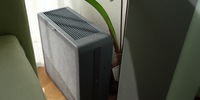
Product test
Quiet, economical, effective: the Renew from Airthings keeps the air clean
by Martin Jungfer

Fan heaters consume a lot of electricity, especially if you let them run uncontrolled and over long periods of time. The «Fara Smart» from Boldr is supposed to be different from other fan heaters. I can confirm – it really isn’t like the others.
Here I am recommending a fan heater. I kindly ask that any calls for me to be stoned be made in the comments below, thank you. If you see red the second the topic of fan heaters comes up and just want to leave a «You’ve got to be kidding me!» in the comments, here’s your chance to skip the article and do just that.
Still here? Alright – then I’ve got a detailed review for you here.
This winter, we’re supposed to be conserving energy across the country. As a result, room temperatures in offices and apartments have dropped. Back in autumn – when this situation was foreseeable – demand for fan heaters spiked. At the time, I advised against such devices across the board.
In the photo accompanying that article of mine, you can see the very fan heater this review is about. Namely, the «Fara Smart» from Boldr. In addition to the «smart» version, which includes a temperature sensor and app control, there’s also a «dumb» version, which you turn on and off with the push of a button.
The «Fara» is about the size of a small shoebox. It’s just 20 centimetres tall, twelve centimetres wide and 13 centimetres deep. With that, it should fit well on a bookshelf – provided there’s a power outlet nearby. The power cable is strikingly short with its 115 centimetres. If I were to put the «Fara» where I actually wanted it, I’d definitely need an extension cord.
Visually, I’m a fan of the «Fara». The brass-coloured ring makes it look more noble than it ultimately is given its plastic casing. However, it’s neatly processed; the edges are smooth, the components are put together well and firmly glued in place. On the flipside, this means any repairs are likely to be difficult, as there’s not a single screw on the «Fara» that would allow you to open the casing.
A sensor also comes in the box. It’s got about the diameter of a ping pong ball and looks a bit like one too. Its design is much less intricate than the fan heater’s; it frankly looks cheap. It can be unscrewed to reveal a CR123 battery and temperature sensor.
Alright, now I’ve got a fan heater and sensor ball, but that’s not enough to bring the heat; the smart version of the «Fara» only turns on if you instruct it to in the app.
The app does a good job guiding me through the setup process. All in all, it’s ready to go after about ten minutes – which included a firmware update for the two Shelly controllers Boldr uses. Both the fan heater and temperature sensor are now connected to my WLAN and can communicate with each other.
The fan heater turns on when the temperature measured in the room drops below the desired temperature, as defined in the app. For example, the temperature I set in «Comfort Mode» is 24 degrees. The sensor measures 22.7 degrees. In this case, the «Fara» will turn on and keep heating until the sensor measures 24 degrees.
On the back of the «Fara» is a toggle switch, which allows me to switch between heating with 800 or 1,200 watts. In addition, the fan heater runs for a maximum of 90 minutes each time it turns on. This ensures that it’s not blindly heating the room if, for example, you’ve accidentally left the window open.
What I especially like in the app is that you can create schedules. This allows you to heat up a room such as your bathroom for the 20 minutes you spend there in the morning and then turn down the heat for the rest of the day. Use cases like this can actually save you money; portable heaters are made for warming up small rooms for a short period of time. On the other hand, they’re not a suitable substitute for proper heaters that provide basic, uniform heating.
The «Fara» app also allows me to keep track of electricity costs. To do so, I enter the high and low tariff periods and the respective cost per kilowatt hour. Unfortunately, I can’t enter the fact that the low tariff starts earlier on Saturday than during the week and that it applies all Sunday, too.
It’s also interesting that the «Fara» always keeps the fan rotating at the same speed – and therefore loudly. The two power levels, 800 and 1,200 watts, don’t affect the fan speed.
Heating your home with the «Fara» can be smart under certain circumstances. For example, if you set the overall temperature (that is, for all rooms) to 17 degrees. Then you’ll be cutting down significantly – by 24 per cent – compared to the 21 degrees we have on average in this country. For each degree you lower, you can expect six per cent lower costs.
The calculation may change if the costs for conventional heating continue to rise as gas and oil become more expensive. As it stands now, you can heat your home with a fan heater without becoming poor or having a guilty conscience, but you can’t really save any money doing so. Not to mention that, as the price of fossil fuels goes up, the price of electricity tends to increase, too.
In everyday life, the Boldr «Fara» is a fan heater that’ll make you happy if you like controlling devices via app and are a fan of if-then commands. Thanks to the Shelly controls, this heater can be integrated into home automation solutions. On the other hand, if you’d prefer to heat up your room at the touch of a button, you’ll be better off with the «dumb» version of the «Fara», which has onboard controls.
Boldr’s «Fara» can’t change the fact that heating prices don’t promote the most environmentally friendly method. Nor would it make sense for heaters that are still working to be switched off and replaced with fan heaters; this would jeopardise grid stability.
I recommend buying a fan heater for a select few use cases only. If you then want a device that looks fancy and has useful features, I can recommend the «Fara» from Boldr. Its smart version includes features that enable energy to be used efficiently.
Journalist since 1997. Stopovers in Franconia (or the Franken region), Lake Constance, Obwalden, Nidwalden and Zurich. Father since 2014. Expert in editorial organisation and motivation. Focus on sustainability, home office tools, beautiful things for the home, creative toys and sports equipment.
A product sample of the fan heater just so happened to be lying around, which is why I ended up using it for illustrations purposes in my first article. After all, it does have quite a pleasing design. What I didn’t expect was the inventors of the «Fara» to get in touch with me. But that’s precisely what they did. The wrote me an e-mail saying I hadn’t been fair to their heater – that smart version of the «Fara» could, in fact, be a reasonable solution. My curiosity was piqued. And so, I took the heater out of the box once more, this time for testing.
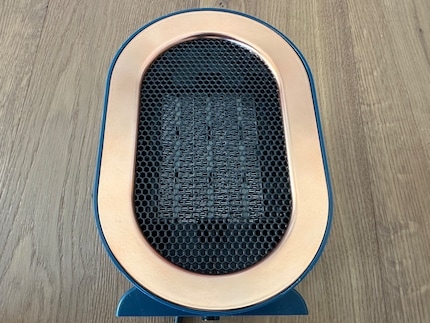
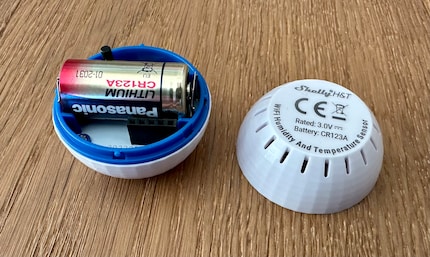
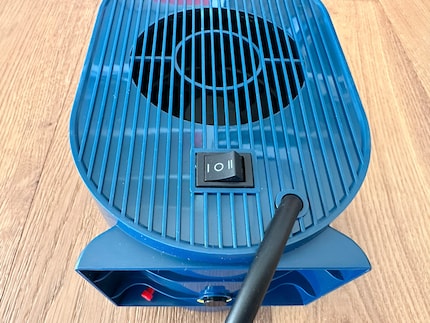
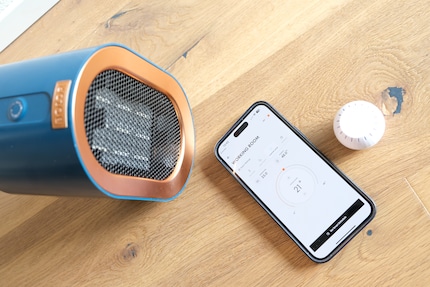
In a small room, the sensor and fan work well together. The ceramic-coated heating element inside the «Fara» is heated electrically; the fan draws in cool air and pushes the heated air back into the room. The volume as this happens is bearable enough. I measure around 51 dB at a distance of one metre, and 47 dB at a distance of two metres. For comparison, 50 dB corresponds to birdsong or soft radio music (link in German). Starting at 40 dB, learning and concentration problems may occur (link in German). Suffice it to say the «Fara» isn’t quiet as a mouse.
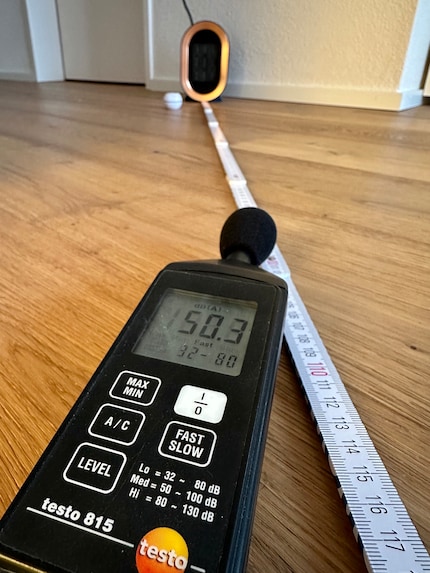
You could use some of the money you save on your overall room temperature to heat the rooms you’re really in with a fan heater. For example, if you go to work every day, you’d probably want the bathroom to be warm in the morning, while the rest of your home may remain cooler. When you get home in the evening, you’d likely want to heat things up again. This amounts to four hours a day of letting the fan heater run. With the «Fara», this takes four kilowatt hours on average, costing about 1.10 francs. This calculation assumes an average electricity price in 2023 of about 27 rappen (link in German).
So, if you’re able to save more money each month by lowering the room temperature than you then spend on electricity for the «Fara», buying it could make sense. On average, heating costs in Switzerland per apartment are currently around 12 francs per square metre of living space per year (link in German). Based on this, a 60 square metre apartment comes to 720 francs per year, or 60 francs per month. If you lowered your room temperature by four degrees, you’d save 24 per cent, or just under 15 francs per month. The electricity needed for the fan heater comes out costlier.
The Boldr is no miracle cost saver in heating. Other heating systems in this country still generate heat much more cheaply in comparison. Owing to the fact that most homes here have good insulation, gas and oil heating systems or heat pumps are the cheaper choice. From a purely ecological point of view, on the other hand, heating with electricity is an interesting idea, especially if the electricity comes from renewable sources. The carbon footprint of fan heaters would then be better than that of fossil-fuel heating systems.